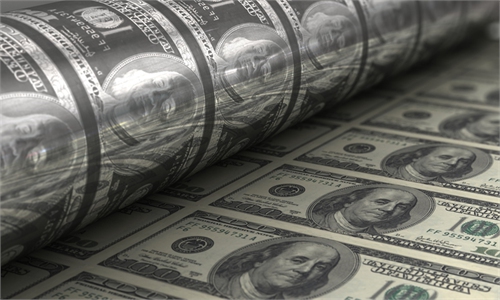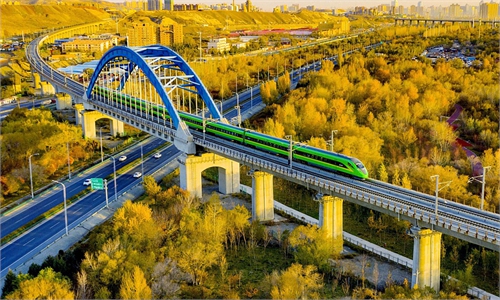
Vehicles for exhibition are transported to the main venue of the upcoming fifth China International Import Expo (CIIE) in Shanghai on October 24, 2022. The CIIE, the world's first dedicated import exhibition, will take place on November 5-10. Photo: Xinhua
China's economy picked up in an all-around way in the third quarter, with its GDP surging by an above-expected rate of 3.9 percent, data from the National Bureau of Statistics (NBS) showed on Monday, as the world's second largest economy is on track for a steady rebound under the government's supportive policies and orderly management of the COVID-19 prevention and control.
China's third-quarter GDP has constituted a robust rebound, after the country's economic growth slowed to 0.4 percent year-on-year in the second quarter, following an unexpected outburst of COVID-19 cases in Shanghai and other domestic cities. In the first quarter, China's GDP growth stood at 4.8 percent year-on-year.
The third quarter GDP growth was also higher than the forecast of many overseas institutions, which generally anticipated China's third quarter GDP growth to be below 3.5 percent.
In the first three quarters of 2022, China's GDP grew by 3 percent year-on-year to hit a total of 87 trillion yuan ($12.01 trillion), compared with a 2.5 percent growth in the first half of this year.
According to a statement published by the NBS on Monday, China's economy has withstood pressure to achieve continued recovery.
"The third quarter economy is evidently better than the second quarter...China's economy operates within a normal range in general," the statement noted.
Experts also stressed that China's economy still presented strong characteristics of being resilient and resistant to pressure, as shown by the GDP performance.
"Seen from the GDP data, China has overcome the negative influence from multiple layers of above-expected blows to see more stable macroeconomic indicators. The characteristic of China's economic growth resilience is evident," Chen Jia, an independent research fellow on international strategy, told the Global Times on Monday.
All-around rebound
Judging from the third quarter GDP statistics, China's economic rebound was balanced, as economic indicators pointed toward a rising trend in most major economic sectors. In the third quarter, China's above-scale industrial added value surged by 4.8 percent, fastening 4.1 percentage points compared with the second quarter.
During the period, fixed-assets investment rose 5.7 percent, up 1.5 percentage points compared with the second quarter, the NBS data showed.
In terms of consumption, China's total retail sales of consumer goods rose by 3.5 percent year-on-year in the third quarter, delivering a sharp rebound from the 4.6 percent drop in the second quarter.
The services also maintained the recovery trend. In the third quarter, China's services industry added value increased by 3.2 percent, compared with a 0.4 percent drop in the second quarter, according to the NBS data.
Customs data also showed that China's trade grew 8.7 percent year-on-year to $4.7 trillion in the first nine months of this year.
"Seen from the economic indicators, China's GDP structure is improving with the three main pillars of economy--trade, consumption and investment becoming more balanced, especially with the consumption sector leaping from negative to positive growth," Chen said.
Hong Tao, a professor with the Beijing Technology and Business University, said that China's orderly economic rebound was largely fuelled by effects of the economic stimulus policy package rolled out by the Chinese government earlier this year, including more than 3.4 trillion yuan of tax cuts and fee reduction in the first nine months, prudent monetary policies as well as other industrial policies.
Besides, China has withstood the tests of natural disasters like drought and floods by rolling out measures to safeguard energy supply, and secured energy and grain safety which guarantees the "foundation" for the third quarter economic recovery, Chen said.
Experts also noted that China's stable political environment, especially after the conclusion of the 20th CPC National Congress that has sent message of consistency and certainty to the world, has created favorable conditions for China's steady economic rebound, in contrast with some major countries' internal chaos which also disrupted their economic rebound.
As China's economy went on a steady rebounding trajectory, overseas financial institutions were also increasingly eying Chinese financial assets when global financial market was under turmoil as a result of geo-political volatility and drastic monetary policies. According to a recent Bloomberg report, UK money manager Abrdn Plc may buy Chinese debt again after selling out three months ago, as a result of rising yields.
Yearly recovery
As China maintains the trend of economic recovery, experts generally expected that the country's economic growth would speed up in the fourth quarter.
Tian Yun, a Beijing-based macro economist, forecast that China's GDP would grow by between 4-4.5 percent in the fourth quarter, which brings the whole-year GDP growth to about 3.4 percent.
"This speed is certainly not high among the average levels of China's development. However, compared to the global scale, it should be said that the level is not low, given the special international background of this year," said Tian.
He also noted that considering the overall inflation rate level, it is estimated that the GDP increment of 2022 will exceed 7 trillion yuan, which is higher than the average annual level of about 6 trillion yuan during the 13th Five-Year Plan period (2016-20).
Hong was a little more optimistic about China's growth prospects this year, as he said that China's consumption peak seasons in September and October would push China's economic growth to hasten further.
Analysts also anticipated that the government is likely to roll out more policies to stimulate economic growth in the coming months. According to a statement sent by Moody's to the Global Times, regulators might announce more supportive policies to bolster house buying demand, such as encouraging affordable housing.
Tian said that from the perspective of industrial recovery, China's economy still needs to further introduce countercyclical adjustment policies to stimulate or promote industrial growth, especially when the industrial inflation level has fallen below the actual growth rate, which might signal industrial deflation in the future.



